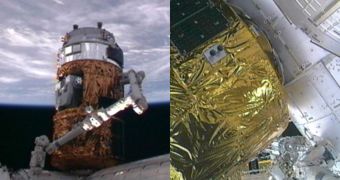According to an official announcement, the resupply cargo spacecraft that Japan sent to the International Space Station last week managed to finally reach its destination yesterday, January 27, after five days of chasing the space lab in orbit.
The vehicle was captured at 6:41 am EST (1141 GMT), as confirmed by two astronauts aboard the orbital facility. Flight engineers Catherine Coleman (NASA) and Paolo Nespoli (ESA) were responsible for grappling the module.
They used the Canadarm2 robotic arm on the exterior of the station to catch the Japanese spacecraft as it was passing within 10 meters (33 feet) of the facility's outer hull. The astronauts had less than two minutes at their disposal to carry out this maneuver.
After the capsule was captured, it was moved into its new home, the Earth-facing docking port on the Harmony module. It will remain here until it's fully unloaded, and then loaded again with waster materials and garbage.
The purpose of the second H-II Transfer Vehicle (HTV2) is to deliver several tons of supplies to orbit, including scientific experiments, space parts, food, water, propellant and personal items for the six members of the Expedition 26 crew.
After the two ISS flight engineers secured the module with the robotic arm, and docked it to its planned home, the spacecraft was held securely into place via 16 bolts. This large number of security measures was meant to ensure that no accidents occur.
HTV2, also called Kounotori 2, was tightly and firmly secured into place at 9:51 am EST (1451 GMT). This is the second unmanned cargo carrier the Japanese Aerospace Exploration Agency (JAXA) builds.
The spacecraft was launched on January 22 at 2:37 pm Japan Standard Time (0537 GMT), from the Tanegashima Space Center in Japan. At first, take-off was planned for January 20, but strong winds at the launch site prevented that plan from materializing.
JAXA says that the HTV2 was delivered to low-Earth orbit (LEO) aboard an expendable H-2B heavy-lift rocket. The spacecraft is capable of delivering the cargo ship, and its 5.3 tons of cargo, to the orbital altitude of the ISS.
The next couple of months will be very busy for the station crew. The six astronauts will receive the visit of space shuttle Discovery, on February 24, and also that of the European Automated Transfer Vehicle Johannes Kepler, on February 15.
An unmanned Russian Progress spacecraft is also due to arrive at the station later this month, or in early February, Space reports.

 14 DAY TRIAL //
14 DAY TRIAL //